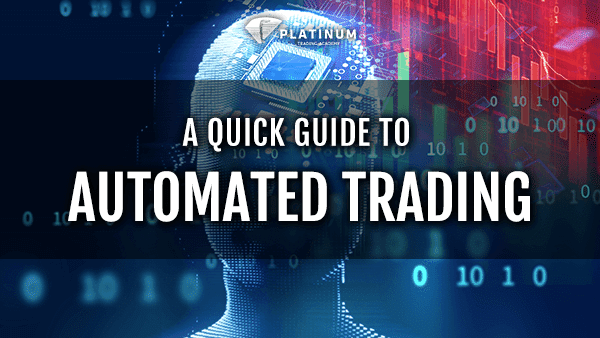Traders deploy a wide array of tools to try and gain an edge while trading the forex market. Automated trading systems have become increasingly popular, given their ability to scan the markets, identify trading opportunities, and execute trades on behalf of traders.
What are Automated Trading Systems?
Automated trading systems are simply trading tools programmed to identify trading opportunities in the trillion-dollar market. The systems are programmed such that they can open and close trades based on a set of rules that meet underlying trading strategies. A good chunk of the stock market’s trading activities is initiated by automated trading systems, given their efficiency in timing entry and exit points.
Automated trading systems have become increasingly popular as they remove emotions out of trading. In this case, traders can stick to rule-based strategies whereby trades are only opened and closed when they meet pre-set criteria.
The exit and entry rules integrated into automated trading systems are based on simple conditions and rules, such as the moving average crossover. Likewise, they can involve the systems studying volume levels and momentum to try and identify ideal entry and exit points.
How Automated Trading systems Work
Automated trading systems work by merely analyzing various currency pairs’ market activity, focusing on the price charts. The systems are configured to identify trading signals, which may include spread discrepancies, price instability patterns, and reactions to various relevant news.
Besides, trading systems come with in-built trading wizards that allow traders to set parameters using various indicators for technical analysis. The use of indicators such as moving averages can enable such systems to open trades whenever the 21-day moving average crosses the 200-day moving average on a huge volume on a five-minute chart. The trading system may also be programmed to open a given market order whenever a given criterion is met.
Automated trading systems allow traders to program their trading strategies and customize indicators for various market conditions. If not fluent with a platform’s programming language, a trader can enlist the skills of a programmer who will be able to integrate their trading rules into the platforms depending on the trading strategy.
Once trading rules are programmed and integrated into a trading system and then trading platforms, the software assumes the role of scanning the market in search of buy and sell opportunities. Once a set-up is identified that meets set-out criteria, a buy or sales order is triggered. Likewise, the system would trigger take profit and stop-loss order as part of money management plays.
Automated Trading Systems Advantages
In addition to executing trades automatically, automated trading systems stand out for many reasons.

Emotionless Trading
Most people lose their hard-earned money on opening and closing trades purely on emotions. Automated trading systems remove the human emotion from trading, allowing trades to be opened and closed based purely on rules. Likewise, such systems allow traders to maintain a form of discipline and stick to a trading plan.
Accessibility
Automated trading systems are not the domain of professional traders alone. Instead, they can also be used by beginners to gain an edge in the trading business. The automated trading system is available in the market at varying levels, prices, and sophistication. Traders are always sure to find a system that meets their needs as well as the goal.
Trading Opportunities
Traders are increasingly turning to automated trading systems, given their ability to scan the market 24 hours a day, searching for trading opportunities. In this case, traders don’t have to spend hours and hours glued to the screen to enter and exit trades. Everything is left to the systems, which also execute trades and lock in profits whenever necessary.
Entry Speed
Prices in the financial markets fluctuate in seconds. Likewise, a fraction of a second can make a big difference in trade being able to generate optimum returns in the forex market. Automated trading systems are known to respond quickly and place orders within seconds allowing traders to make good use of emerging opportunities.
Diversification
While traders can only pursue trading opportunities on a limited number of securities, automated trading systems take diversification to another level. The programmed systems scan multiple markets at a given time using various strategies in pursuit of trading opportunities.
Disadvantages of Automated Trading systems
Monitoring
Automated trading systems are not the holy grail of trading. The fact that humans develop such systems means they are prone to errors. Likewise, they require constant monitoring to ensure they are working as expected.
Technical failures such as loss of internet or computer malfunctions can render the systems functionless.
Expensive
Some automated trading systems cost a fortune. One may have to invest a considerable amount of money into such systems to generate losses.
Scams
Many traders in the forex market have fallen victim to automated trading systems scams. Some developers offer systems that promise instant rewards and daily returns, which is always not the case. Traders should always be on the lookout as many systems don’t work as they claim to.
Bottom Line
Automated trading systems are valuable instruments for traders who know what they are doing in the market. Such systems are designed to scan and pursue trading opportunities as long as the market is opened. Likewise, they relieve traders of the burden of having to stay glued to the screen all the time. The fact that they avert human emotion from trading ensures a disciplined approach to opening and closing trades in the forex market.
While such systems don’t guarantee 100% profit all the time, they ensure traders make the most of market movements. Unlike humans, such systems are known to lead to better outcomes given their ability to enter and exit trades based on set out criteria. Likewise, they work more articulately and coherently.